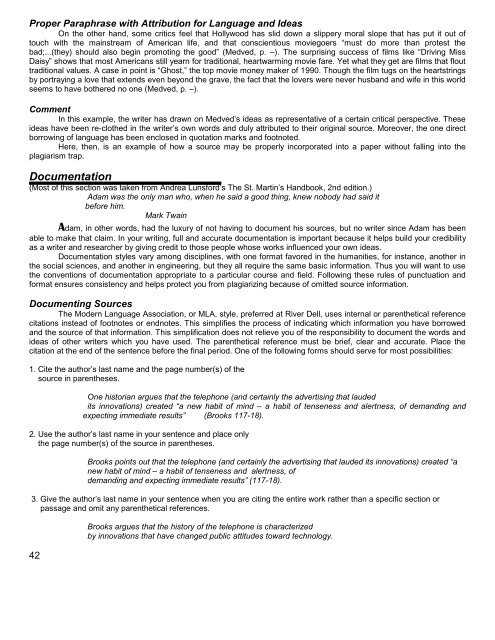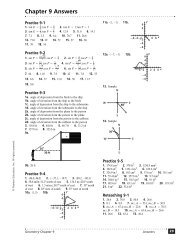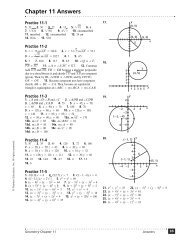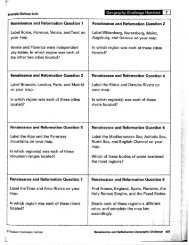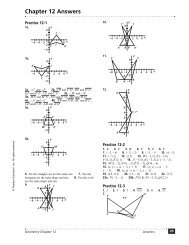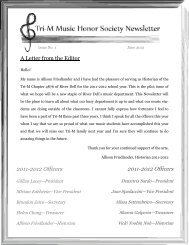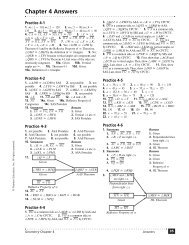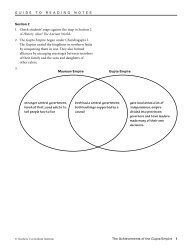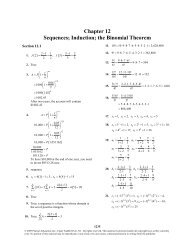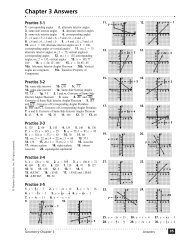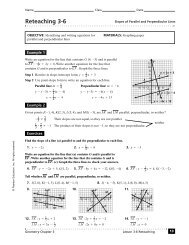High School Handbook - River Dell Regional School District
High School Handbook - River Dell Regional School District
High School Handbook - River Dell Regional School District
You also want an ePaper? Increase the reach of your titles
YUMPU automatically turns print PDFs into web optimized ePapers that Google loves.
Proper Paraphrase with Attribution for Language and Ideas<br />
On the other hand, some critics feel that Hollywood has slid down a slippery moral slope that has put it out of<br />
touch with the mainstream of American life, and that conscientious moviegoers “must do more than protest the<br />
bad;...(they) should also begin promoting the good” (Medved, p. –). The surprising success of films like “Driving Miss<br />
Daisy” shows that most Americans still yearn for traditional, heartwarming movie fare. Yet what they get are films that flout<br />
traditional values. A case in point is “Ghost,” the top movie money maker of 1990. Though the film tugs on the heartstrings<br />
by portraying a love that extends even beyond the grave, the fact that the lovers were never husband and wife in this world<br />
seems to have bothered no one (Medved, p. –).<br />
Comment<br />
In this example, the writer has drawn on Medved’s ideas as representative of a certain critical perspective. These<br />
ideas have been re-clothed in the writer’s own words and duly attributed to their original source. Moreover, the one direct<br />
borrowing of language has been enclosed in quotation marks and footnoted.<br />
Here, then, is an example of how a source may be properly incorporated into a paper without falling into the<br />
plagiarism trap.<br />
Documentation<br />
(Most of this section was taken from Andrea Lunsford’s The St. Martin’s <strong>Handbook</strong>, 2nd edition.)<br />
Adam was the only man who, when he said a good thing, knew nobody had said it<br />
before him.<br />
Mark Twain<br />
Adam, in other words, had the luxury of not having to document his sources, but no writer since Adam has been<br />
able to make that claim. In your writing, full and accurate documentation is important because it helps build your credibility<br />
as a writer and researcher by giving credit to those people whose works influenced your own ideas.<br />
Documentation styles vary among disciplines, with one format favored in the humanities, for instance, another in<br />
the social sciences, and another in engineering, but they all require the same basic information. Thus you will want to use<br />
the conventions of documentation appropriate to a particular course and field. Following these rules of punctuation and<br />
format ensures consistency and helps protect you from plagiarizing because of omitted source information.<br />
Documenting Sources<br />
The Modern Language Association, or MLA, style, preferred at <strong>River</strong> <strong>Dell</strong>, uses internal or parenthetical reference<br />
citations instead of footnotes or endnotes. This simplifies the process of indicating which information you have borrowed<br />
and the source of that information. This simplification does not relieve you of the responsibility to document the words and<br />
ideas of other writers which you have used. The parenthetical reference must be brief, clear and accurate. Place the<br />
citation at the end of the sentence before the final period. One of the following forms should serve for most possibilities:<br />
1. Cite the author’s last name and the page number(s) of the<br />
source in parentheses.<br />
42<br />
One historian argues that the telephone (and certainly the advertising that lauded<br />
its innovations) created “a new habit of mind – a habit of tenseness and alertness, of demanding and<br />
expecting immediate results” (Brooks 117-18).<br />
2. Use the author’s last name in your sentence and place only<br />
the page number(s) of the source in parentheses.<br />
Brooks points out that the telephone (and certainly the advertising that lauded its innovations) created “a<br />
new habit of mind – a habit of tenseness and alertness, of<br />
demanding and expecting immediate results” (117-18).<br />
3. Give the author’s last name in your sentence when you are citing the entire work rather than a specific section or<br />
passage and omit any parenthetical references.<br />
Brooks argues that the history of the telephone is characterized<br />
by innovations that have changed public attitudes toward technology.


